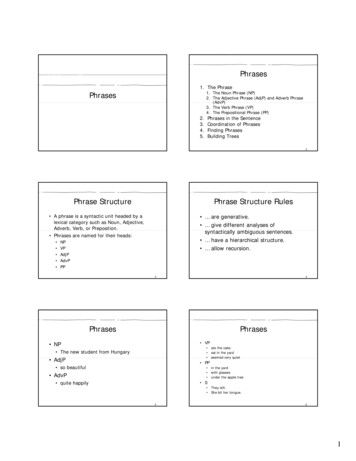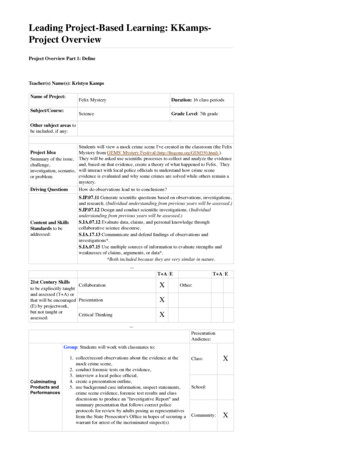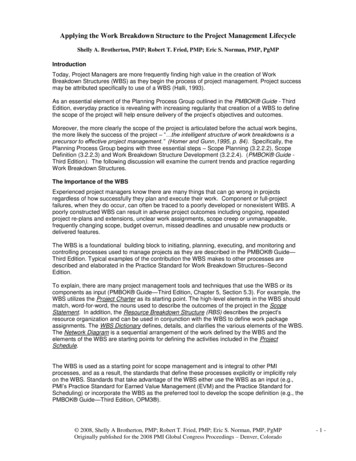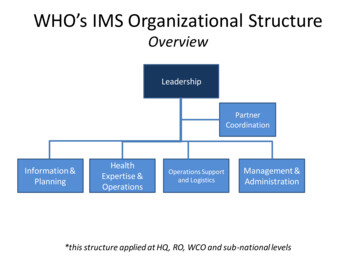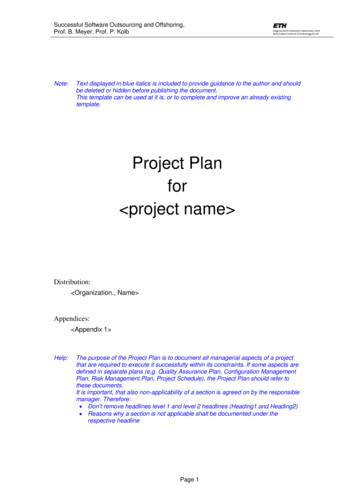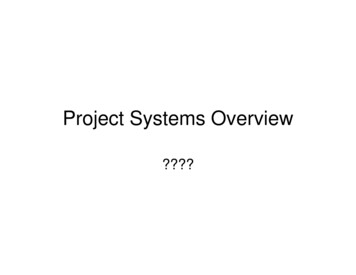
Transcription
Project Systems Overview?
What is a ProjectWhat is a Project?According to the PMBOK Guide, First Edition, Version 1.0, June 2003: "A project is a temporary endeavor undertaken to create a unique product orservice." "Temporary means that every project has a definite beginning and a definiteend date. The end is reached when the project's objectives have beenachieved, or . cannot be met, or the need for the project no longer exists.“According to SAP: A project is a summary of certain business processes within an enterprisethat can be defined by the uniqueness of its conditions:––––––Precise goalsTime, money, or personnel restrictionsUse or defined resourcesComplexityCross departmental processingTypically follow the order of concept, rough cut planning, detailed planning,approval, execution, completion
Project FunctionsFunctions of a Project: Define the purpose or product to be completedOrganize the work to be accomplishedSeparate the work into smaller, manageable pieces and activitiesProvide a framework on which to plan the project requirements,using both internal and external resources Capture actual performance data on the same framework, which canbe used for comparisons Provide a consistent format for tracking and reporting projectinformation for management decision making Provide a permanent record of project performance which can beanalyzed for future performance improvements
Project Types Direct Projects – Are used to plan and manage reimbursable work forcustomers within and outside of the organization. Planning is performed onnetwork activities/elements. Exist at Echelon II and Echelon III. Sales OrderpresentOverhead (Non-Statistical) Projects – Are used to plan for and managework funded with overhead – planning is performed on networkactivities/elements. Exist at Echelon II and Echelon III. No Sales OrderService Center Projects – Are used as cost collectors for Service Centersand other Cost Redistribution Accounts (CRAs) – planning is performed onnetwork activities/elements. Exist at Echelon II and Echelon III. No SalesOrderStatistical Overhead Projects – Are used to plan for and trackorganizational overhead expenses – planning is performed on the statisticalWBS elements. There are no network activities/elements for this type ofproject. Exist at Echelon II and Echelon III. No Sales OrderBudget Structures – Are used at Echelon II commands to support thePlanning, Programming, Budgeting, and Execution System (PPBES) and tosupport the creation of Budget Exhibits. These structures will also be usedto pass funds to field activities and prime contractors/OEMs and to captureExpense Operating Budget (EOB) employee labor hours/costs. No networksare included in this structure. Exist at Echelon II only. No Sales OrderCapital (CPP) Projects – Are used for the modernization and improvementof Working Capital Fund (WCF) activities, functions and equipment items.Capital assets are items such as automated data systems, software tools,and minor construction - planning is performed on networkactivities/elements. Exist at Echelon II and Echelon III. No Sales Order
Project StructureActivity Element
Project DefinitionEstablishes defaults for theWBS elements to be createdKey Information –Project IDProject ProfileCompany CodeBusiness AreaPlantPerson Responsible
WBS Structure Serves as a model of the project that shows the project deliverablesin hierarchical form Thereby represents the structure organization of the project andprovides a phase, function, or product-oriented description of theproject Outlines the project in manageable sections Individual elements of the WBS are called WBS elements Depending upon the project phase, you can break down the WBSelements further The WBS is the operative basis for:–––––CostRevenuePayment planningTime schedulingBudget allocation in projects
WBS Element HierarchyWBS elements are frequently established in an inverted tree structure. Onlythe lowest level WBS elements of the tree should collect costs (or networkactivities subordinate to these WBS elements). Billing elements can not besubordinate to another billing element.
Work Breakdown StructureFour varieties: Place Holder – no operative indicators Planning – planning element operative indicator Billing – billing element operative indicator Account Assignment – acct asst elem. operativeindicator
Place Holder WBS Generally top level of budget structureprojects Does not receive any postings May be used for reporting purposes
Planning WBSUsed to plan costs and durations
Billing WBS Hold funding Connects project with sales order May identify budget structure to which it isattached
Account Assignment WBS Capture Expenditures through subordinatenetwork activities Exist on lowest level of Statistical OH Projects Exist on lowest level of Budget StructureProjects
Network Describes the time sequence and dependenciesof events and activities in a project and therebyrepresents the course of the project Consists of fundamental elements– Activities– Relationships Networks and their activities for capacity,materials, resources, and services that arerequired for carrying out a project and it’s tasks
Network Header Basic Data: copies to subordinate elements Profile: determines functions and assignments Subordinate to a WBS element
Network Activity Activities can be scheduled using activity durationsActivities have relationships with other activitiesWhen activities are assigned to WBS elements, the dates and costs can be defined inthe individual activities and are aggregated at the WBS level and can be evaluated.Activity costs already assigned are checked against the budgets of the WBSelements.All expenditures in Direct, Capital, Service Center, and non-statistical OverheadProjects (General and Production) are posted to network activities or activityelementsActivity elements–––Subordinate to an ActivityAssumes Activity scheduleIf present, becomes chargeable object Two types:– Internal– External– General Cost A.K.A. – JON
Internal ActivitySpecifies the work required from an internal source Number of work hours By Work center Activity type (from CO: cost rate for the labor) Number of workers (can specify by individual) Duration (only at the Activity)
External ActivitySpecifies the resources to be obtained externally Material/Components to be purchased Services to be purchased
General Cost ActivityCost Activity specifies work to be performed for which there may be aprimary cost estimate. An example of this type of activity might be projectrelated travel or communication expenses.
Activity Element Provides further breakdown of network activity Allows assignment of personnel with differentcompetencies to be assigned to the sameactivity (e.g. a plumber and an electrician) Allows different funding to be assigned todifferent portions of a network activity Looks and acts like a network activity Internal and external activity elements
Milestone A point in time defining a level of accomplishment or point of required action
Project Process Steps Establish: Create project structure Plan–––– Schedule and DatesCosts-Internal requirements (Labor)Costs-External requirements (Procurement)Costs-General requirements (Incidental)Fund/BudgetExecuteMonitor & ControlComplete– Physical– Financial Close
Project Budgeting Direct Projects – Funding PR/PO Overhead (Non-Statistical) Projects –XXXX Service Center Projects – XXXX Statistical Overhead Projects - None,budgeted to responsible cost center Budget Structures – Direct FMBB Capital (CPP) Projects – XXXX
ReleaseWithin Standard SAP, actual postings can not occur until the receiver objecthas been released.This SAP standard has almost NO relevance to ?, ? hasdeveloped procedures and techniques to assure that SAP conforms to? requirementsTransaction XXXX will release the WBS to which budget is being assigned.Transaction XXXX will release the WBS (in the case of budget structureprojects) or network activities selected. This transaction will also assignUser Status of FASG (funding assigned) to the objects selected.A user status of FASG is required to charge expenditures to any costobject.Transaction XXXX will release the billing WBS element identified in theSales Order Line Item
ReleaseWBSFor NWA, press thebutton to see user status
Long TextUsers may enter as much text as they like on theproject header, WBS elements, network headersand network activities.There are very limited formatting capabilities.Use the Document Management System to attachnicely formatted documents to your WBSelements and network activities.
Project Cost Planning WBS element planning– Budget Structure WBS– Overhead WBSNetwork Activity planningVersions ––––––––––––0 Current Active Plan Version001 through 099 – What if Versions200 – Performance Management Baseline – Used in Direct projects where Earned ValueManagement is utilitized.*300 through 399 – OSD Budget Versions – Used for Budget Structures only. These areformal cost planversions representing the annual OSD budget submittal. Budget Exhibits will be created fromdata in theseversions.*400 through 499 – President’s Budget Versions – Used for Budget Structures only. Theseare formal cost planversions representing the annual President’s Budget submittal. Budget Exhibits will becreated from data inthese versions.*500 through 599 – POM/Program Review Versions – Used for Budget Structures only.These are formal cost plan versions representing the annual POM/Program Reviewsubmittal. Budget Exhibits will be created from data in these versions.600 through 699 – Cash Quarter (OM&N) Versions – Used for Budget Structures only. Thesecan be used to plan OM&N spending by quarter if desired.
WBS Element Planning WBS Planning may be used for statisticaloverhead projects and budget structure projects Structure Planning – total lump sum for WBSelement, may be used for statistical overheadprojects Unit Cost Planning – planning by vendor, mustbe used for budget structure projects
WBS Structure PlanningEnter total planned expenditures for each WBS element. Ifthere is a WBS element hierarchy, only enter the amountsfor the lowest level WBS elements and ‘Total Up’
WBS Unit Cost PlanningAfter saving and back arrow
Network Cost Planning Internal Activity Planning– Quantity based– Work center (competency)– Activity type– Activity type rate External Activity Planning– Dollar based
Internal Activity Cost Planning
External Activity Cost Planning
According to SAP: A project is a summary of certain business processes within an enterprise that can be defined by the uniqueness of its conditions: – Precise goals – Time, money, or personnel restrictions – Use or defined resources – Complexity – Cross departmental processing – Typically follow the order of concept, rough cut planning, detailed planning, approval, execution .
